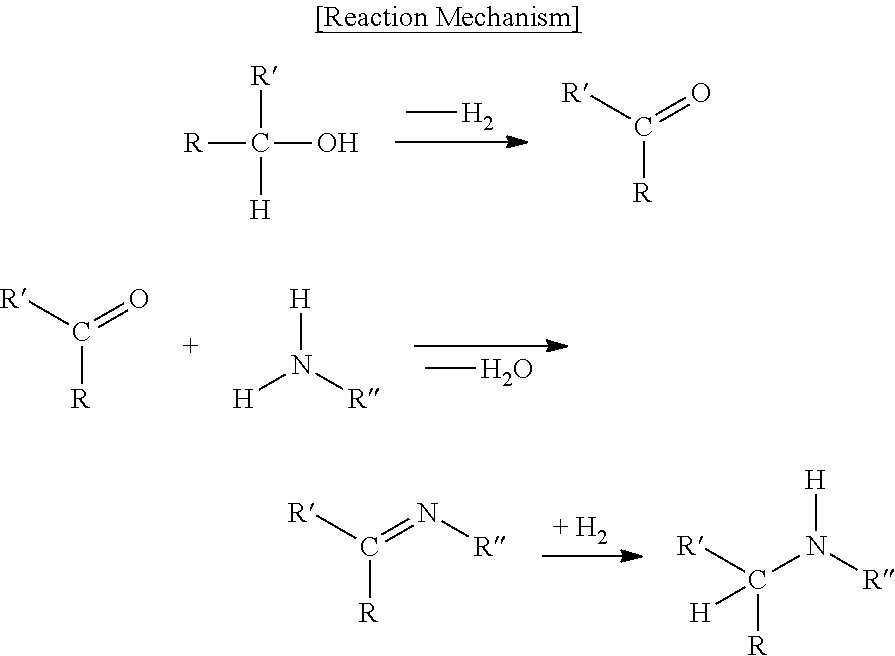Catalyst for reductive amination-reaction and uses thereof
a technology of amination reaction and catalyst, which is applied in the preparation of amino compounds, physical/chemical process catalysts, metal/metal-oxide/metal-hydroxide catalysts, etc., can solve the problems of reducing overall production efficiency, complex facilities, and reducing reaction efficiency, and achieve high amine conversion rate
- Summary
- Abstract
- Description
- Claims
- Application Information
AI Technical Summary
Benefits of technology
Problems solved by technology
Method used
Image
Examples
example 1
Preparation of CoO—Y2O3 Catalyst
[0106]At room temperature, about 44.034 g of cobalt nitrate and about 0.525 g of yttrium nitrate were dissolved in about 400 g of water, and the precipitation method was carried out by injecting 15 wt % aqueous solution of sodium carbonate with a speed of about 0.08 ml / s.
[0107]After about 1 hour passed, the formed salt was washed and filtered numerous times by using about 500 ml of distilled water, and it was dried at about 110° C. for about 15 hours.
[0108]The CoO—Y2O3 catalyst (including about 6.03 parts by weight of Y2O3, based on 100 parts by weight of CoO) was obtained by the method of putting the salt dried like above into a furnace and raising the furnace temperature up to about 600° C. with a heating rate of about 300° C. / hr, and calcining the salt for about 4 hours at about 600° C. under ambient atmosphere.
example 2
Preparation of CoO—Y2O3—PdO Catalyst
[0109]At room temperature, about 44.034 g of cobalt nitrate and about 0.525 g of yttrium nitrate were dissolved in about 400 g of water, and the precipitation method was carried out by injecting 15 wt % aqueous solution of sodium carbonate with a speed of about 0.08 ml / s.
[0110]After about 1 hour passed, the formed salt was washed and filtered numerous times by using about 500 ml of distilled water, and it was dried at about 110° C. for about 15 hours.
[0111]The salt dried like above was put into a furnace, and calcined for about 4 hours at about 600° C. under ambient atmosphere after raising the furnace temperature up to about 600° C. with a heating rate of about 300° C. / hr.
[0112]The CoO—Y2O3—PdO catalyst (including about 6.03 parts by weight of Y2O3 and about 0.13 parts by weight of PdO, based on 100 parts by weight of CoO) was obtained by the method of adding 20 ml of an aqueous solution in which about 0.028 g of palladium nitrate was dissolved t...
example 3
Preparation of CoO—Y2O3—PdO Catalyst
[0113]At room temperature, about 44.034 g of cobalt nitrate and about 0.525 g of yttrium nitrate were dissolved in about 400 g of water, and the precipitation method was carried out by injecting 15 wt % aqueous solution of sodium carbonate with a speed of about 0.08 ml / s.
[0114]After about 1 hour passed, the formed salt was washed and filtered numerous times by using about 500 ml of distilled water, and it was dried at about 110° C. for about 15 hours.
[0115]The salt dried like above was put into a furnace, and calcined for about 4 hours at about 600° C. under ambient atmosphere after raising the furnace temperature up to about 600° C. with a heating rate of about 300° C. / hr.
[0116]The CoO—Y2O3—PdO catalyst (including about 6.03 parts by weight of Y2O3 and about 0.26 parts by weight of PdO, based on 100 parts by weight of CoO) was obtained by the method of adding 20 ml of an aqueous solution in which about 0.056 g of palladium nitrate was dissolved t...
PUM
| Property | Measurement | Unit |
|---|---|---|
| pressure | aaaaa | aaaaa |
| temperature | aaaaa | aaaaa |
| pressure | aaaaa | aaaaa |
Abstract
Description
Claims
Application Information
 Login to View More
Login to View More - R&D
- Intellectual Property
- Life Sciences
- Materials
- Tech Scout
- Unparalleled Data Quality
- Higher Quality Content
- 60% Fewer Hallucinations
Browse by: Latest US Patents, China's latest patents, Technical Efficacy Thesaurus, Application Domain, Technology Topic, Popular Technical Reports.
© 2025 PatSnap. All rights reserved.Legal|Privacy policy|Modern Slavery Act Transparency Statement|Sitemap|About US| Contact US: help@patsnap.com



